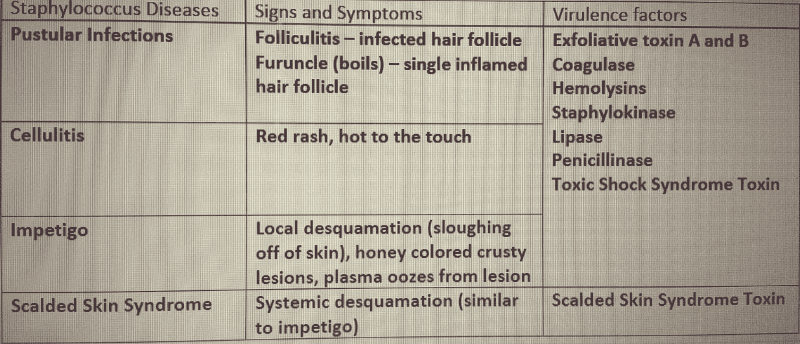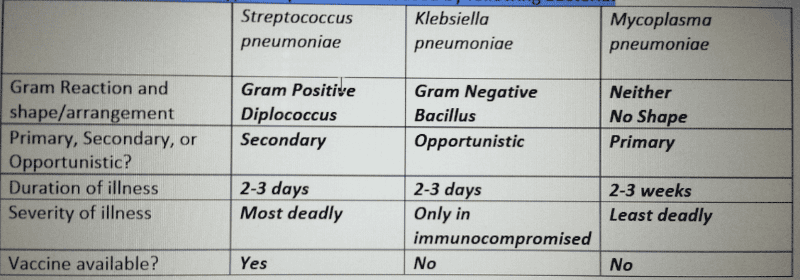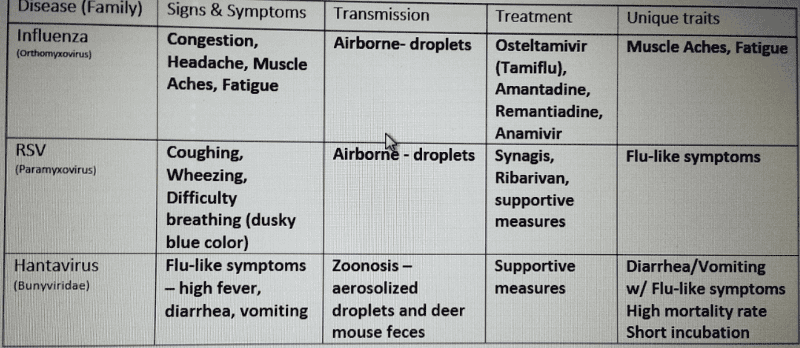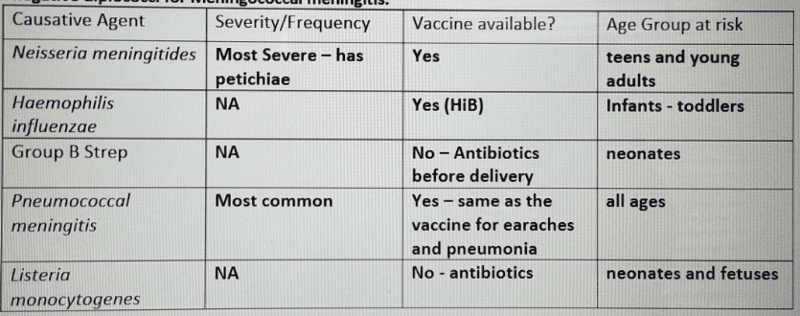What are the three main categories of identifying an unknown bacteria to the genus and species level?
- Phenotypic
- Genotypic
- Immunological Methods
Describe phenotypic and give examples of tests
-identification is based on traits expressed and involve the following subcategories
- Microscopic (gram stain) and Macroscopic (observations of colonies)
- morphology
- Physiological/Biochemical Characteristics (fermentation and enzyme tests like SIM and Carbohydrate Fermentation)
- Chemical Analysis (analysis of chemical composition – such as the cell wall structure)
Describe Genotypic and give examples of tests
- Includes genetic analysis
- Polymerase Chain Reaction (PCR)
- G+C composition
Describe Immunological and give examples of tests.
-Using the antigen/antibody response to help diagnose infection.
- Agglutination
- Precipitation
- Immunodiffusion
- Complement Fixation
- Fluorescent Antibody tests
- Immunoassay tests
What term describes the “most dilute solution that produces a visible result?”
titer
When antibodies clump whole cells together, indicating a particular organism or cell is present, this is called an _______ reaction.
agglutination
When antibodies combine with an equal amount of antigens producing an insoluble substance this is called a _______ reaction.
precipitation
When typing blood, which test is used to determine your ABO type?
Which is used to determine the Rh antigen?
- hemagglutination – blood
- Coombs test – Rh
What substances are the reactants in a complement fixation test?
patient’s serum, antigen, complement
What is the indicator for the complement fixation test?
sheep's blood
What is the appearance of a positive result for a particular antigen in the complement fixation test?
no lysis
What is the appearance of a negative result for a particular antigen in the complement fixation test?
lysis
In the indirect Fluorescent Treponema Absorbance (FTA) test, what is added to the slide first?
syphilis spirochete
What is the second substance added to the slide for the FTA test?
serum from patient
What is the third substance added to the slide for the FTA test?
fluorescent-labeled anti-human IgG antibody
What is the appearance of a positive result for syphilis in the FTA test?
glowing spirochetes
In the indirect ELISA test, what is added to the wells first?
bead covered with HIV antigen
Where do you get the Primary Antibody (this is added second) for the ELISA test?
patient's blood
What is the third substance added to the wells during an ELISA test?
enzyme linked anti-human antibody
What is the fourth substance added to the wells during the ELISA test?
substrate
Skin and eye infections
- staphylococcus - bacterial (Staphylococcus aureus )
- herpes - viral
- varicella - Zoster - viral
- Leishmaniasis - protozoal
Neurological infections
- Meningitis
- Rabies
- Toxoplasmosis
Respiratory infections
- Pneumonia
- Respiratory Syncicial virus
- Influenza
- Hentavirus
Cardiovascular & Lymphatic infections
- Tularema
- Epstein Barr Virus (mono)
- Malaria
Digestive
- E. Coli
- Clostridium difficile
- Cryptosporidium
Genitourinary
- UTI
- Syphilis
- Trichomonas
- HPV
Describe the shape, arrangement, and Gram Stain results for Staphylococcus aureus
Coccus, Staph, Gram Positive
What Primary isolation media is used to identify Staphylococcus aureus?
Mannitol Salt Agar (salt tolerant and mannitol fermenting) or Blood Agar (Beta hemolysis)
What is the appearance of Staphylococcus aureus on this media?
Yellow around growth on MSA; Clear around growth on Blood Agar
Name two non-culture –based methods used to identify S. aureus
- Bacti-staph – Passive Agglutination test (If it agglutinates, then positive for S. aureus)
- Coagulase test – using plasma (if it forms clots it is coagulase positive)
List viruses in the Herpes family and differentiate between the diseases caused by these viruses
- Herpes Simplex Virus I (HSV-I or cold sores)
- Herpes Simplex Virus II (HSV-II or Genital Herpes)
- Varicella-Zoster Virus (HHV-III or Chicken Pox-Shingles)
- All are DNA viruses of the Herpes Family. They are enveloped viruses with an icoshedral capsid.
- The main difference in these viruses are how they are transmitted and the nerves which harbor the latent form of the virus. Lesions are slightly different as well.
Differentiate between HSVI and HSVII.
- HSVI: Causes cold sores: Transmitted by contact, latent in the trigeminal ganglion nerve which innervates areas of the face, lesions are usually found on the face or around the mouth where the trigeminal nerve comes to the surface of the skin. Can cause up to 30% of neotnatal encephalitis.
- HSVII: Genital Herpes: Sexually transmitted, latent in the sacral ganglia, lesions on internal/external genitalia, thighs, and buttocks.
What virus is associated with chicken pox and shingles?
Varicella-Zoster
What are the major symptoms of chicken pox and shingles?
- Pox are an itchy macular lesion that become encrusted and flake off sometimes leaving scars. The lesions start on the face and scalp and spread to the extremities
- Shingles will erupt due to stress – it causes the virus to become lytic and it travels along the thoracic or trigeminal sensory nerves to the surface of the skin (along the dermatomes) on the back and face. The lesions are more like fluid filled vesicles, very painful and sensitive to touch. Due to inflammation of the nerve – the pain and tenderness can persist for several months
How are chicken pox and shingles related?
Chicken pox is the first form of the virus. The latent form of the virus is Shingles.
Can you “catch” shingles from someone with shingles? With chickenpox?
No, you cannot catch shingles, but you can contract chickenpox.
Are there any preventative measures for chickenpox? Explain
There are vaccines for both Chicken pox and Shingles. The Varicella vaccine is given to children who have not had chicken pox. The Zostavax vaccine is only given to people 60 years or older who have had the chickenpox
What is Leishmaniasis and how is it transmitted?
- it is
- transmitted through an infected sand fly that bites a host.
Where is Leishmaniasis endemic?
The sand fly indigenous to the Middle East, so the disease is found in the Middle East in countries like Iraq, Saudi Arabia, and Afghanistan.
What are the treatment and preventative measures used against Leishmaniasis?
- Prevention involves controlling the sandfly population.
- Treatment is with pentavalent Antimony and pentamidine or Amphotercin B if the organism is resistant to the Antimony alone.
Differentiate between antigenic shift and antigenic drift
- shift: a large change in the flu virus hemagglutinin spikes. This results from swapping of one RNA segment from a human virus with the RNA from a pig or avian flu virus. This makes the human population vulnerable because it does not have the antibodies and memory cells for this new virus
- drift: what happens each year. Antigens on the Hemagglutinin spike mutate each year
Why do we need to be vaccinated each year?
because of antigenic drift
List the diseases associated with Staphylococcus aureus and their signs/symptoms, and virulence factors associated with each disease.

Describe the shape, arrangement, and Gram Stain results for
Staphylococcus
aureus
Coccus, Staph, Gram Positive
What Primary isolation media is used to identify Staphylococcus aureus ?
Mannitol Salt Agar (salt tolerant and mannitol fermenting) or Blood Agar (Beta hemolysis)
What is the appearance of Staphylococcus aureus on this media?
Yellow around growth on MSA; Clear around growth on Blood Agar
Name two non-culture –based methods used to identify S. aureus
Bacti-staph – Passive Agglutination test (If it agglutinates, then positive for S. aureus ) Coagulase test – using plasma (if it forms clots it is coagulase positive)
List viruses in the Herpes family and differentiate between the diseases caused by these viruses.
- Herpes Simplex Virus I (HSV-I),
- Herpes Simplex Virus II (HSV-II or Genital Herpes),
- Varicella-Zoster Virus (HHV-III or Chicken Pox- Shingles) and
- Cytomeglovirus (CMV
All are DNA viruses of the Herpes Family. They are enveloped viruses with an icoshedral capsid
Differentiate between HSVI and HSVII
- Herpes Simplex I – Causes cold sores: Transmitted by contact, latent in the trigeminal ganglion nerve which innervates areas of the face, lesions are usually found on the face or around the mouth where the trigeminal nerve comes to the surface of the skin. Can cause up to 30% of neotnatal encephalitis.
- Herpes Simplex II – Genital Herpes: Sexually transmitted, latent in the sacral ganglia, lesions on internal/external genitalia, thighs, and buttocks.
What virus is associated with chicken pox and shingles?
Varicella-Zoster
What are the major symptoms of chicken pox and shingles?
- Varicella-Zoster: Pox are an itchy macular lesion that become encrusted and flake off sometimes leaving scars. The lesions start on the face and scalp and spread to the extremities.
- The Zoster (Shingles) virus will erupt due to stress – it causes the virus to become lytic and it travels along the thoracic or trigeminal sensory nerves to the surface of the skin (along the dermatomes) on the back and face. The lesions are more like fluid filled vesicles, very painful and sensitive to touch. Due to inflammation of the nerve – the pain and tenderness can persist for several months. In the shingles along the ophthalmic root of the trigeminal nerve, it can cause an inflammation of the eye and facial paralysis
Where is Leishmaniasis endemic?
The sand fly indigenous to the Middle East, so the disease is found in the Middle East in countries like Iraq, Saudi Arabia, and Afghanistan. Therefore, this is a concern for our troops in the Middle East. However, some versions of Leishmaniasis are found in Latin America ( L. mexicana, L. brasiliensis) China and India (L. tropica ).
What are the treatment and preventative measures used against Leishmaniasis
Prevention involves controlling the sandfly population. A
recombinant DNA vaccine is being developed. Treatment
is with pentavalent Antimony and pentamidine or
Amphotercin B if the organism is resistant to the Antimony
alone.
Compare the various types of pneumonia caused by following bacteria:

Compare (similarities) and contrast (differences) the diseases caused by the following viruses: Influenza, Respiratory Syncytial Virus, and Hantavirus

Differentiate between antigenic shift and antigenic drift. Why do we need to be vaccinated each year?
Antigenic shift is a large change in the flu virus hemagglutinin spikes. This results from swapping of one RNA segment from a human virus with the RNA from a pig or avian flu virus. This makes the human population vulnerable because it does not have the antibodies and memory cells for this new virus. Antigenic drift is what happens each year. Antigens on the Hemagglutinin spike mutate each year. This is the reason why a new flu vaccine is needed
Describe the 4 main groups of pathogenic Escherichia coli .
- Enterohemoraggic – E. coli O157:H7 (EHEC) – see below
- Enteropathogenic – causes infantile diarrhea (most notably in developing countries – profuse watery diarrhea, fever, vomiting). EPEC causes effacement of gut surfaces like EHEC, similar to EHEC, but does not produce shiga toxin.
- Enterotoxigenic – causes severe diarrhea due to two toxins – heat labile (LT) and stable toxins (ST) as its name suggests. It is a self-limiting illness and is mainly treated with fluid replacement.
-
Enteroinvasive – inflammatory diseases similar to Shigella –
blood and pus are usually found in the stool with
this. However, this bacteria does not produce shiga toxin.
Primarily transmitted by contaminated food and
water in developing countries, this disease is treated
with fluid replacement.
What is the Gram Reaction for E. coli? What is the shape of this bacteria?
Gram negative, Rod-shaped
What are the symptoms of the E. coli O157:H7 illnesses? Virulence Factors?
Bloody diarrhea, fever, sometimes hemolytic uremic syndrome (which leads to kidney failure). The symptoms are due to the shiga toxin (main virulence factor).
Describe the symptoms, causes, and prevention of Clostridium difficile
Diarrhea illness resulting from the use of broad spectrum antibiotics. The antibiotics can kill bacteria that are sensitive to the antibiotics. Since C. difficile are resistant to the antibiotics, they survive. Then, because they have survived, and there is more room to grow with plenty of nutrients, they will take over the colon.
Prevention – give narrow spectrum antibiotics and handwashing
Compare and Contrast Hepatitis A, B, and C

What is Cryptosporidium and how are humans infected?
Cryptosprodium is a protozoal organism that causes a gastrointestinal infection. They are infected by contaminated water.
What are the major symptoms of cryptosporidium infection?
Diarrhea, vomiting, sweating, and severe abdominal cramping that lasts for 2 weeks.
How do water treatment plants control the spread of cryptosporidium?
Normally they treat with chlorine, but many times this is not enough. Therefore filtration along with chlorination have been implemented. It is estimated that 1/3 of fresh water sources in the world have the cysts of cryptosporidium.
List the bacterial causes, transmission, and general symptoms of Urinary Tract Infections.
Escherichia coli (80%), Staphylococcus saprophyticus (5-10%), and Enterococcus (5-10%) are the causes of UTIs. They are transmitted by accidental contact from fecal matter and due to the small length of the urethra are more common in females than males. General symptoms include pain, itching, and burning upon urination
List and describe the causative agent of Syphilis
Treponema pallidum is the causative agent of syphilis. This is a spirochete bacteria.
Describe the three stages of Syphilis.
- Primary – involves a hard chancre (shang ker) which is evident on the genitalia.
- Secondary – IF UNTREATED IN THE PRIMARY STAGE - involves a rash on the palms of the hands that spreads all over the body and flu-like symptoms.
- Tertiary –IF UNTREATED - involves gummas on organs throughout the body (and sometimes on the skin). This can involve the nervous system (neurosyphilis) which can result in personality change, an awkward gait (how they walk), can lead to comma and then death
Describe prevention and treatment for Syphilis.
Since Syphilis is a sexually transmitted disease, abstinence, monogamy, and protection during sex are all ways to prevent Syphilis. Salvarsan (a derivative of atoxyl containing arsenic, which was discovered in the early 1900s by Paul Ehrlich) and Penicillin (available since the 1940s however some are allergic) are treatments for Syphilis. Other antibiotics are also effective but Penicillin is less toxic and still effective if the patient is not allergic.
Describe the causative agent and disease caused by Trichomonas vaginalis
Trichomonas is a protozoan with flagella.
Compare meningitis caused by bacteria: causative agent, severity, vaccine available, and age group at risk

General symptoms involve a headache, stiff neck, and fever
Compare viral and bacterial meningitis: Which is more common? Which is more severe?
Viral meningitis is less severe but more common than Bacterial.
Luckily, most bacterial meningitis can be treated
with antibiotics and most viral meningitis can be fought off by
your
immune system.
Describe the causative agent of Rabies.
Rabies virus is a large bullet shaped RNA virus with a helical capsid and envelop; of the Rabdoviridae family
What are the signs and symptoms of Rabies?
- Furious rabies - Periods of agitation, disorientation, seizures, and twitching. Spasms in the neck and pharyngeal muscles lead to hydrophobia
- Dumb rabies - Patient is not hyperactive but is paralyzed, disoriented, and stuporous
What is the prevention/treatment for Rabies?
Vaccines are available for occupational exposure to animals
that may be rabid. Post-exposure vaccine – 5
intramuscular shots given immediately after exposure
includes antibodies against the rabies virus as well as
antigens which stimulate the immune response to
produce memory cells and antibodies to fight off and prevent
replication of the virus
Explain how this preventative/treatment is unique
Because this is a post-exposure vaccine rather than a pre-exposure vaccine, it is a unique vaccine. This preventative/treatment is only possible because the virus is so slow in replicating that there is time to get the vaccine and produce antibodies and memory of the event before it can replicate.
Describe the causative agent of Toxoplasmosis.
toxoplasma gondii
What are the signs and symptoms of Toxoplasmosis?
The signs and symptoms are asymptomatic or marked by mild symptoms such as sore throat, lymph node enlargement, and low-grade fever. In immunocompromised patients and infants, it is often fatal.
What is the prevention and treatment for Toxoplasmosis?
Prevention involves hand washing and if pregnant or immunocompromised, having someone else change the cat litter box, or not having a cat.
Who is most at risk of Toxoplasmosis?
The most at risk for Toxoplasmosis include babies in the womb and immunocompromised persons.
What is the common name for the disease caused by Francisella tularensis ?
Rabbit Fever is the common name for Tularemia which is caused by F. tularensis.
What are the signs, symptoms for this disease?
Symptoms: headache, backache, fever, chills, malaise, and weakness Further symptoms tied to the portal of entry: ulcerative skin lesions, swollen lymph glands, conjunctival inflammation, sore throat, intestinal disruption, pulmonary involvement
What is the mode of transmission?
The bacteria are in droplets are formed when skinning the animal. There are multiple portals of entry – Cutaneous infection: skin from tick bite or a cut or scrape; Ophthalmic infection: from droplets that get into the eye; Pulmonary: from breathing in the droplets
What is the prevention and treatment for this disease?
Prevention involves waiting until the first hard freeze to hunt small game animals (which should have killed any of the bacteria on small game animals in your area)
What microorganism causes Infectious mononucleosis?
Epstein-Barr Virus (EBV) is the most common cause, but Cytomeglovirus (CMV) can cause the disease in immunocompromised hosts (in AIDS patients).
What is the mode of transmission for Infectious Mononucleosis?
Direct or indirect contact with saliva (kissing, drinking after someone)
How can it be prevented?
Not using the same glass to drink out of, avoiding drinking fountains. Avoid “swapping saliva” with someone with the virus.
Compare the various diseases associated with this microbe
- EBV-depending on health at time of infx, may never know they were infx, mononucleosis, Hodgkin's or Burkett's lymphoma or chronic fatigue syndrome
- Mono Sx include: sore throat, fever, cervical lymphadenopathy, gray white exudates in throat, rash, enlarged spleen
- Hodgkin's & Burkett's are blood CAs of lymphocytes
Why do some people get mono and others get more severe diseases?
It seems that the more immunocompromised you are when you get the symptoms, the more severe the manifestation of the disease
Explain how cancer can be caused by this microbe (EBV)
When viruses penetrate and cause infection, the result can be an acute or persisting infection. Some use the lysogenic method of replication which means they integrate their DNA into the host cell DNA. In integrating their DNA with the host, they either turn on oncogenes (cancer causing genes) or turn off tumor suppressor genes. This is how viruses can cause cancer.
Describe the microorganism responsible for malaria and what type of microbe is it?
- Plasmodium malariae, P. vivax, P. ovale, and P. falciparum.
- Eukaryotic, Protozoan
What are the
- signs, symptoms,
- method of transmission,
- prevention, and
- treatment for this microorganism?
- flu-like Sx that progress to fever and chills
- female anapholes mosquito
- controlling mosquito population & bednets
- quinine, chloroquine, or mefloquine
Name the STORCH diseases. What do the letters STORCH represent?
- S – Syphilis
- T – Toxoplasmosis
- O – Other – including Hepatitis B, AIDS, and Chlamydia
- R – Rubella
- C – Cytomeglovirus
- H – Herpes
What are the STORCH diseases?
These are diseases which can affect the fetus during critical development periods resulting in congenital birth defects, miscarriage, and death